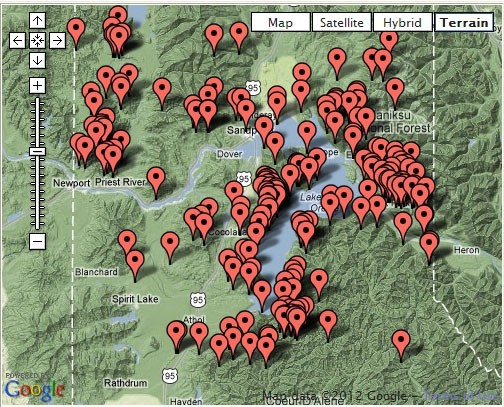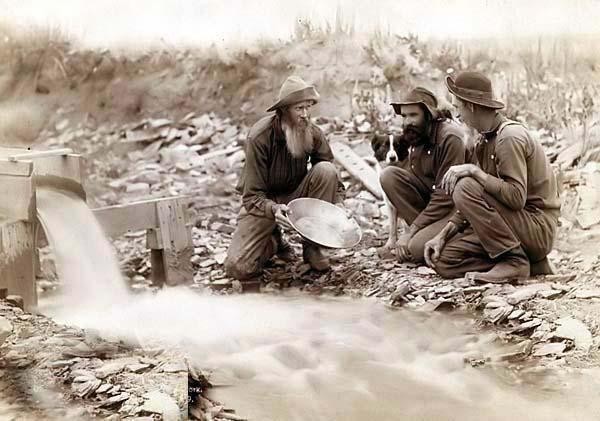Gold Mining in Idaho
Post on: 24 Июнь, 2015 No Comment

Gold Mining in Idaho
Although Idaho is perhaps best known for its agricultural production of potatoes as well as a center of design for semiconductor chips. the state is richly endowed with a surplus of natural resources that extend well beyond the exports of a golden root vegetable and innovative memory products. Idahos state nickname is the “Gem State” because nearly every known gem has been found there. The mostly mountainous region of the Northwestern United States is one of only two areas in the world that star garnets have been discovered and is also the exclusive home of six pointed star garnets. In addition to gold the impressive variety of important metals found in Idaho reads like a laundry list including: antimony. beryllium. chromium. cobalt. copper. lead. molybdenum. phosphate. platinum. silver. thorium, tungsten. vanadium. and zinc . The most significant contributors of these deposits to the state economy are silver, phosphate, lead, and zinc. At present, Idaho produces the most newly mined silver and is the second largest producer of phosphate in the nation, representing almost 45 percent of all silver and 15 percent of phosphate produced on an annual basis.
Historic context
In the autumn of 1860, a party of ten prospectors entered the Nez Perce Reservation in search of mineral wealth and after a challenging month of frustration, Wilbur Bassett discovered the precious metal along Canal Gulch. Rich gold discoveries in the Boise Basin in 1863 encouraged two thousand miners to rush to the upper Snake River believing there was gold in abundance. It was this gold rush that brought the first permanent white settlers to Idaho and caused the state territory to be established by President Abraham Lincoln in 1863. According to the United States Geologic Survey (USGS), Idaho was a leading placer-mining state and from 1860-1866 was credited with producing as much as 19 percent of all gold equivalent to approximately 2.5 million ounces. By the late 1800s silver, lead and zinc deposits were uncovered in the Coeur dAlene area.
Geologic context
A series of digital maps, data files, and reports were generated by the USGS to provide geologic process and mineral resource information with short-term predictions of future mineral-economic activity and longer term forecasts to account for the future discovery of extensions of known mineral deposits, as well as for the future discovery of presently undiscovered mineral deposits. The report employs quantitative estimates of presently undiscovered mineral resources with some generalizations made about the likely areal distribution of undiscovered deposits in the Interior Columbia Basin Ecosystem of the Pacific Northwest suggesting that 58 percent of the estimated mean undiscovered gold resources are considered to occur in a contiguous area of southeastern Oregon, southwestern Idaho, and northeastern Nevada. predominantly in shallowly deposited vein and hot springs deposits.
A classic mesothermal vein deposit has been discovered in the Coeur d’Alene District. One of the chief dredging areas is in the Boise Basin, a few miles northeast of Boise, in the west-central part of the state with other placer deposits located along the Salmon River and on the Clearwater River and its tributaries, particularly at Elk City, Pierce, and Orofino. Extremely fine-grained (or flour) gold is found in sand deposits along the Snake River in southern Idaho.
Current developments and political context
In an exclusive interview with Gold Investing News. Virginia S. Gillerman, Economic Geologist with the Idaho Geological Survey indicated a “serious increase in gold exploration in Idaho the last couple years.” She expects that, “it will be a very busy field season – somewhat delayed by a hefty snowpack this year.” Major gold plays are at some of Idaho’s historic gold producing areas, with increased activity last year, and continuing into this year.
In the most recent Fraser Institute’s Survey of Mining Companies: 2010/2011 , Idaho has demonstrated a modest improvement from last year’s assessment, situated within the top half of jurisdictions and placing between Arizona and New Mexico for its relative investment climate towards mineral extraction. The survey is based on the opinions of mining executives representing 429 mineral exploration and development companies on a series of criteria including how mineral endowments and public policy factors such as taxation and regulation affect exploration investment in 79 jurisdictions around the world.
Mineral exploration and investment potential
Western Pacific Resources Corp. (CVE:WRP ) is focused on precious metal properties in Idaho and Nevada. In August 2009, the company obtained 345 claims in southeastern Cassia County in Idaho known as the Mineral Gulch property. The project encompasses the historic Black Pine Mining District with sporadic small-scale gold and base-metal mining occurring in the area as early as 1915. Pegasus Mining acquired the property from Noranda and produced over 500,000 ounces of gold from several small open pits in the late 1980s through the mid-1990s.

In April Vista Gold Corp. (TSE:VGZ ) (AMEX:VGZ ) announced the successful completion of a December agreement to combine assets with Midas Gold, a private company that controlled the majority of the Yellow Pine Stibnite district, which encompassed a number of historic past producing mines. Towards the end of last month, Midas reported a mineral resource estimate for the Golden Meadows project. In aggregate, the company reports that the three gold deposits within the project are estimated to contain an indicated mineral resource of 2.05 million ounces of gold and an additional inferred mineral resource of 3.74 million ounces of gold.
Atlanta Gold Inc. (CVE:ATG ), a junior gold exploration and development company with properties in Idaho, Quebec and Nunavut has recently made a series of announcements regarding additional property acquisition and project exploration plans. The 2011 exploration objective is to test the continuity of a shear zone at vertical depths below 610 meters and test the northwest trending structure to increase the gold mineral resource by the end of 2011. A number of environmental and development-related initiatives include accommodating infrastructure related to the Atlanta project and reconstructing buildings for on site warehouse and office space.
Premium Exploration Inc. (CVE:PEM ) is focused on gold exploration at its district-sized land package in North-Central Idaho near Elk City in the Orogrande shear zone. The company’s goal is to ultimately develop the multiple near-surface gold resources along its property stretching in excess of 30 kilometers. Its strategy of drilling structures identified by geophysics and gold-in soil trends has led to three gold discoveries and significant resource development with five potential zones of mineralization.
Otis Gold Corp. (CVE:OOO ) is engaged in the business of acquiring and exploring unproven mineral interests including the Kilgore Gold project in Clark County, and several other properties located in Lemhi County. Last month the company reported positive gold recoveries from column leach tests performed on bulk samples from the Kilgore Mine Ridge. The project has a NI 43-101 compliant resource of 218,000 ounces of drill-indicated gold and 269,000 ounces of inferred gold. During its 2011 operations it plans on performing large diameter column leach tests on a coarser crush size conducting additional analytical and characterization work to further enhance the resource.
Terraco Gold Corp. (CVE:TEN ) (PINK:TCEGF ) has a combination of early and advanced stage gold-silver projects in Idaho and Nevada. The company’s Almaden project is located east of Weiser and north of Boise. The project hosts a National Instrument 43-101 compliant measured plus indicated resource of 864,000 ounces of gold and an inferred resource of 84,000 ounces of gold at near surface. The advanced- stage Almaden project has excellent access with good infrastructure and includes 887 drill holes. In mid April Terraco announced that its 2011 exploration program is now underway, beginning with two core rigs designed to confirm higher grade zones of gold near the surface and to test for high-grade, bonanza-style, structurally-controlled gold mineralization at depth.
Get the latest Gold Investing News articles delivered to your email inbox. Learn more














